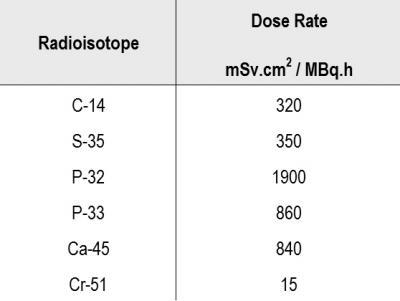Radioisotope Beta Skin Contamination Dose Rates
Published: Sep 29, 2021
Source: Ionactive Radiation Protection Resource

The table above provides values of mSv/h (equivalent dose) for various radioisotope skin (surface) contamination. The values are 'per MBq' over an area of 1cm2. For other values of activity, multiply the dose rate by the new activity (in MBq). For other values of surface area, divide the dose rate by the actual surface area (in cm2).
The values are derived from IAEA-TECDOC-162; they should only be used for educational purposes. In a comparison test with the 'Varskin Code' they over estimate the dose (dose rate) by about 10%.
Any contribution from x-rays (Bremsstrahlung) is ignored.
The values show the importance of avoiding skin contamination - even from low energy beta emitters. In addition, as far as P-32 is concerned you can more or less ignore the attenuation offered by a pair of laboratory grade gloves - therefore monitor gloves!
Cr-51 is included for comparison (emissions via electron capture).
Please also note that these figures are calculated by considering the absorbed dose in skin. Do not use dose rate data for beta absorbed dose in air and try to infer skin dose by the inverse square law.
Worked examples
Here is a worked example to show how the resource can be used.
Example - P-32 worker
An employee is working with 37 MBq of radioactive P-32 in 0.5 ml liquid. They extract 0.1 ml of this liquid with the intention of transferring to an eppendorf tube for further dilution. Instead of transferring into the tube, they inadvertently drop the liquid droplet onto a finger tip. They are wearing gloves, although in this example the beta attenuation in the glove material is negligible. They then place the tube in a well counter to obtain a baseline measurement of activity, but are surprised to find counts are not much above background (indicating no substantial radioactivity in the dilution liquid). Deciding to cease the experiment they monitor their gloved hands and discover off-scale readings using their GM based radiation monitoring (> 1000 CPS) on one finger tip of the right hand. They quickly remove the glove and wash their hands and re-monitor, they find no residual activity above background on their finger tip.
Whilst they are inclined to put this issue 'down to experience', they mention the incident to their Radiation Protection Adviser (RPA), whom on hearing the amount of activity involved does some simple calculations.
- The assumed activity on the finger tip is 7.4 MBq (1/5 of total activity being used).
- On talking the the employee, they estimate the time of exposure before glove was removed is 1 minute.
- They estimate the area of contamination on the glove (and therefore the finger) is no greater than 1 cm2.
Using the data in the above table we can state the following:
- For P-32, we read from the table that the dose rate is 1900 mSv/cm2 / MBq.
- Therefore, since the assumed area is 1 cm2, we can state that the dose rate in this case would be 14060 mSv/h.
- Since the time of exposure is estimated as one minute, the contact dose is estimated as 234 mSv.
- This is nearly half of the extremity dose limit for someone occupationally exposed to ionising radiation (500 mSv/year equivalent dose), and substantially above the threshold for classified person status (150 mSv/year equivalent dose to the extremity).
- The above dose / year values are based on the UK Ionising Radiations Regulations 2017.
In this example you can see that the dose delivered is significant over such a small period of time (1 minute).
